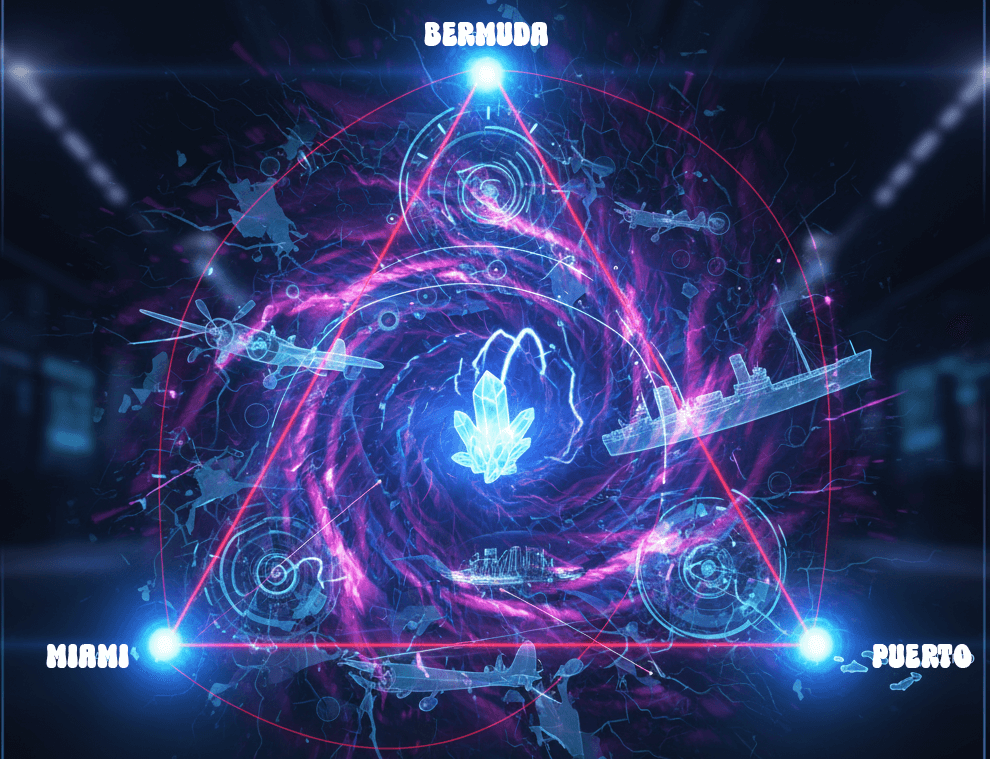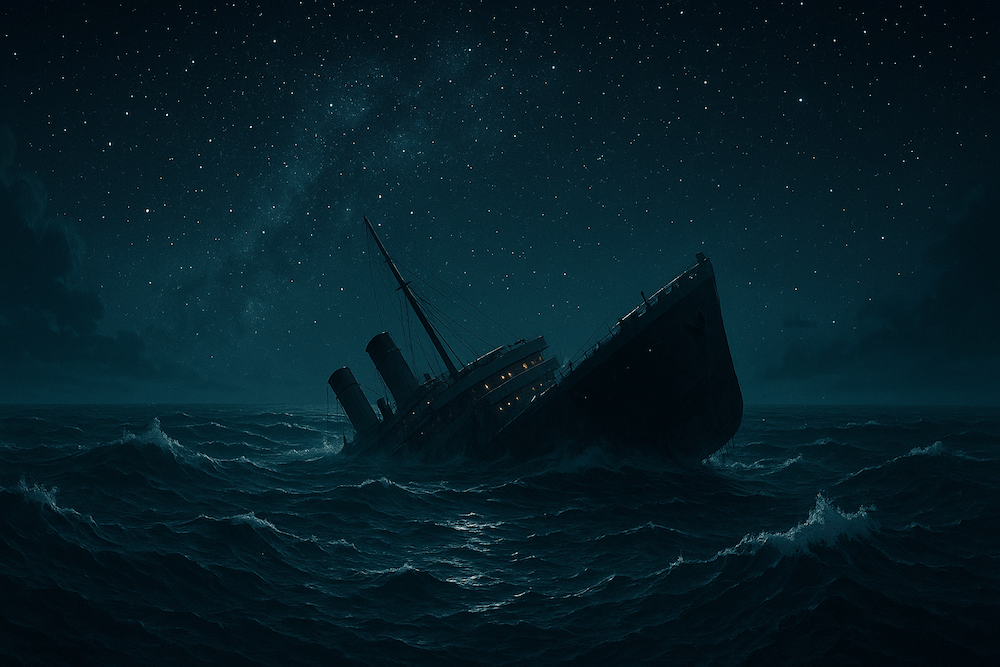In the depths where science meets the unknown, where logical minds face the impossible
The Atlantic Ocean goes on forever under a blanket of stars. Its dark waters hold secrets that have puzzled people for hundreds of years. The Bermuda Triangle is one of the ocean's most mysterious places. It's a place where the lines between the known and the unknown seem to fade away like morning mist over troubled waters.
Yet beneath the sensational headlines and Hollywood dramatizations lies a far more profound mystery: not what happens in these waters, but why we, as a species, are so desperately drawn to the inexplicable. The Triangle is like a mirror that shows us our deepest fears about the huge unknown that surrounds our small area of understanding.

The Shape of Fear
The idea of a "triangle" in the ocean shows us something important about how people think. We make the chaos of nature more orderly by putting geometric shapes on it and making boundaries where there were none before. Miami, Bermuda, and Puerto Rico are the three points of the Triangle. This makes it easy for our brains to understand, but the ocean doesn't care about these made-up boundaries.
In 1492, Christopher Columbus sailed these waters and wrote in his log that his compass needle began to point toward true north instead of magnetic north. This is something that scientists today still can't explain. Five hundred years later, we know that this happens along the "agonic line," where the Earth's magnetic field lines up perfectly with geographic north. But Columbus's comment suggests something more: the Triangle has always been a place where our instruments, which we rely on most for navigation, let us down.
The Vanished: Stories That Stay with You
Flight 19: The Last Hours of the Lost Squadron
The fifth of December, 1945. Not only what happened on that date, but also what didn't happen, is famous in aviation history. Five Grumman TBM Avengers flew in perfect formation and then just disappeared.
Lieutenant Charles Taylor's last messages show that he was getting more and more confused, which is more than just a mistake in navigation. His radio messages, which are still kept in Navy archives, show a man watching his world fall apart:
"Both of my compasses are broken. I'm trying to find Fort Lauderdale. I'm over land, but it's broken. I'm pretty sure I'm in the Keys, but I don't know how far down."
The transcript gets more and more desperate:
"Dammit, if we could just fly west, we would get home. Head west, dammit!"
But here's the first big mystery: Taylor was a skilled pilot with more than 2,500 hours of flying time. The navigation exercise was normal. It was nice outside. But somehow, five planes and fourteen men disappeared so completely that not a single piece of wreckage was ever confirmed found, even though the U.S. had one of the largest peacetime search operations in history.
The USS Cyclops: A Giant That Was Swallowed by Silence

March 1918. The USS Cyclops left Barbados for Baltimore with 11,000 tons of manganese ore on board. There were 306 people on board the ship, which was 542 feet long and made of steel. It's not normal for ships this big to just vanish.
But it did disappear, leaving behind only questions that get more disturbing with each decade that goes by. Recent declassified naval intelligence papers show things that official histories left out:
Captain George Worley was being looked into because of some strange things he had done. Some crew members had said that things were going wrong, that the route was changing for no reason, and that there were secret communications. When the ship's manifest was finally looked at decades later, it had some problems that made it look like the cargo wasn't all it was cracked up to be.
Even more troubling: the manganese ore on board the Cyclops was going to steel production plants that were part of the war effort. The ship's disappearance means something worse in 1918, when German U-boats were patrolling these waters.
But the most puzzling thing is Cyclops's sister ships. During World War II, both the USS Proteus and the USS Nereus disappeared in the same waters while carrying the same cargo along almost the same route. Three ships of the same type, carrying the same kind of cargo, and meeting the same end. The chance of coincidence gets closer to zero.
The Science of the Impossible
Strange things that happen in Earth's magnetic field
Recent magnetometric surveys have shown something amazing about the Bermuda Triangle area: localized magnetic field fluctuations that happen with such strength and frequency that they don't happen anywhere else on Earth. Dr. Bruce Gernon, a pilot who says he went through a "time warp" in the Triangle, talks about flying through what he called "electronic fog." This made his plane's three-hour flight take only 75 minutes.
Some people don't believe these stories, but the University of Southampton's research on electromagnetic fields has found strange "ionospheric disturbances" over the Triangle area. Theoretically, these disturbances, which happen in the part of the atmosphere where GPS and radio signals travel, could cause:
- Temporal displacement effects in electronic navigation systems
- Radio frequency anomalies that stop distress calls from being sent
- Instrument failure cascades where more than one system fails at the same time
The Methane Hydrate Connection: Earth's Secret Weapon
There is a huge methane hydrate deposit on the ocean floor under the Bermuda Triangle. These crystal structures, which were made under a lot of pressure, hold more energy than all known fossil fuel reserves put together. But they are also very unstable.
Dr. Karl Kruger at the University of Oslo has mapped huge craters on the seafloor that were made by methane explosions. Some of these craters are more than half a mile wide. According to computer models, a sudden release could:
- Make a "density void" in the water, which will make ships lose buoyancy right away
- Make the levels of methane in the air high enough to make airplane engines catch fire
- Create electromagnetic pulses from the chemical reaction that could stop electronic systems from working
Timing is very important: methane releases often happen after "seismic activity," and the Triangle region is on a fault line where small earthquakes happen all the time but are often missed.
Rogue Waves: The Ocean's Hidden Killers
The Gulf Stream, the Antilles Current, and the Caribbean Current all meet at the Bermuda Triangle. This convergence makes it possible for rogue waves to form, which can reach heights of 100 feet with almost no warning.
Dr. Susanne Lehner from the German Aerospace Center has used satellite data to find "hotspots" for rogue waves all over the world. The Bermuda Triangle area has the most rogue waves in the North Atlantic.
These waves don't just sink ships; they wipe them out. A rogue wave can hit a ship and crush it so badly that there are only a few pieces of debris that are spread out by currents before search teams get there.
The Theories That Aren't Spoken
The Link to the Deep State
Documents from the 1960s that have been made public show that the CIA had a "special interest" in events that happened in the Bermuda Triangle. Project BLUE PAPER, which was only partially made public in 2019, told operatives to look into "unusual disappearances in strategic maritime zones."
The timing is right in the middle of the Cold War, when both superpowers were testing out electromagnetic warfare systems and submarine detection technologies. Some former naval intelligence officers, who asked to remain anonymous, have said that some of the Triangle disappearances may have been:
- Testing secret weapons that went wrong
- Foreign submarine activity that was kept secret to keep things from getting out of hand internationally
- Experimental technology being moved through the area
The Consciousness Field Hypothesis
Dr. William Tiller, a retired professor at Stanford University, has put forward what may be the most controversial idea: that the Bermuda Triangle is a consciousness-matter interaction zone. His research shows that under certain electromagnetic conditions, human consciousness can change the physical world.
Mainstream science has rejected Tiller's hypothesis, but there are several disturbing observations that support it:
- Temporal perception anomalies reported by survivors of the Triangle
- Equipment behavior that goes against known laws of physics
- Psychological effects on rescue personnel that are similar to what has been said in liminal space research
The Mind Behind Mystery
Why We Need the Unexplainable
In today's world, the Bermuda Triangle plays an important psychological role. We need mysteries to stay mysterious in a time when satellite images can show every square meter of the Earth's surface and GPS can find us within inches.
Dr. Susan Greenfield, a neuroscientist at Oxford University, says that the human brain is built to look for patterns and explanations. When we face events that we can't explain, we feel a kind of "cognitive vertigo" that can be both scary and exciting.
The Triangle makes us think that there are still places where the impossible can happen, where the strict rules of physics might bend, and where wonder can win over everyday life.
What They Don't Tell You About Modern Investigations
Problems with Satellites
NASA keeps an eye on Earth's oceans with satellites all the time, but they've never made public any data about Triangle incidents. Several Triangle events have been linked to, according to anonymous sources within the agency:
- Sudden heating of the atmosphere seen in infrared satellite images
- Electromagnetic disturbances that make reconnaissance satellites temporarily blind
- Gravitational anomalies found by precise measuring tools
The Living Mystery
Recent Missing Persons
The Triangle keeps taking lives. Recent events that didn't get much media attention are:
2020: The cargo ship MV Stellar Daisy and all 24 crew members went missing. For three hours after the ship disappeared from radar, its automated systems kept sending data.
In 2021, a family of four on a 40-foot yacht made a routine radio check-in and then was never heard from again. Search teams found their life raft, which was completely intact and unused, floating 200 miles from where they were last seen.
A Coast Guard helicopter on a routine training mission in 2023 reported "unusual weather phenomena" before losing contact. Even though the weather was perfect for flying, the plane and crew were never found.
How Often Silence Happens
The pattern of communication failure is probably the most upsetting thing about Triangle disappearances. It should be almost impossible for there to be complete communication blackouts now that we have satellite communications, GPS beacons, and emergency locator transmitters.
But Triangle incidents always involve "total communication silence," which means there are no mayday calls, no emergency beacon activations, and no final transmissions. It seems like the victims go from being alive to not being alive without any time in between.
The Deeper Truth
In the end, the Bermuda Triangle isn't about ships that go missing or planes that go missing. It's about what it means to be human: our relationship with mystery, our need for wonder, and the limits of what we know.
Science elucidates numerous aspects of the Triangle: the magnetic anomalies, the environmental influences, and the statistical probabilities. But science also shows us something deeper: that our planet has forces and events that we are only starting to understand.
The quantum field, the electromagnetic spectrum, and the deep ocean are all places where the impossible becomes just unlikely, and the line between science and mystery becomes so thin that it doesn't matter.
Conclusion: Accepting the Unknown
The Bermuda Triangle will always be there because it shows something important about being human: our relationship with the unknown. In a world that is becoming more and more mapped, measured, and explained, we need places where wonder can grow and the impossible can still happen.
It doesn't matter if the Triangle's events are caused by nature, human error, or something we don't yet understand. What matters is what it stands for: a reminder that the universe is much stranger and more wonderful than our models suggest.
The ocean is good at keeping secrets. And maybe, in our hurry to explain everything, we've forgotten that some mysteries are meant to stay that way—not because they can't be solved, but because solving them would take away something important from the human spirit.
The biggest mystery of the Bermuda Triangle might be this: why do some places refuse to be explained at all in a universe that seems determined to reveal all its secrets?
The answer, like the Triangle itself, will always be beautiful, stubborn, and unknown.
